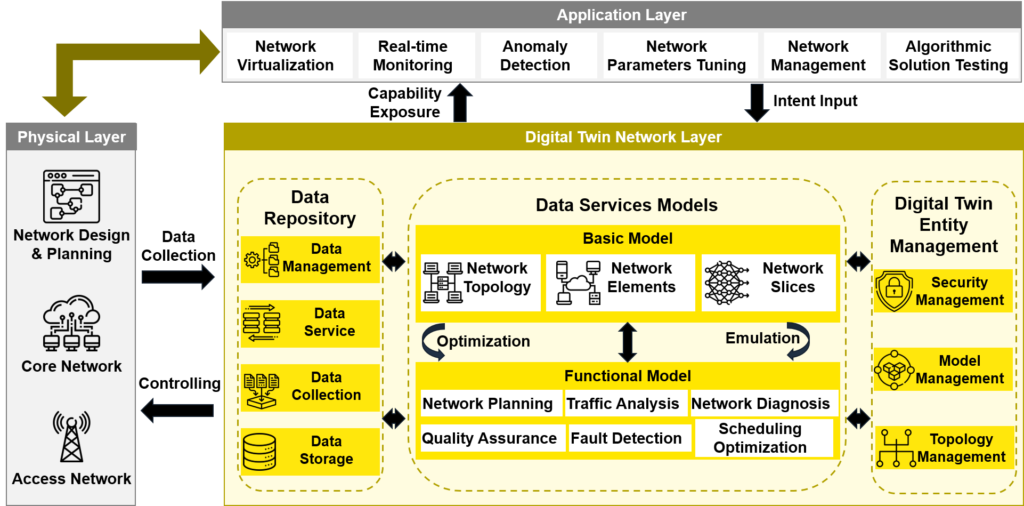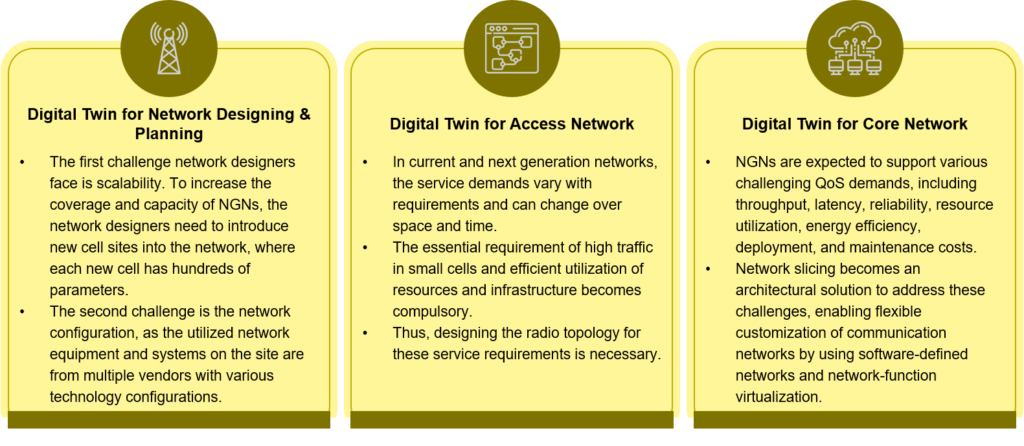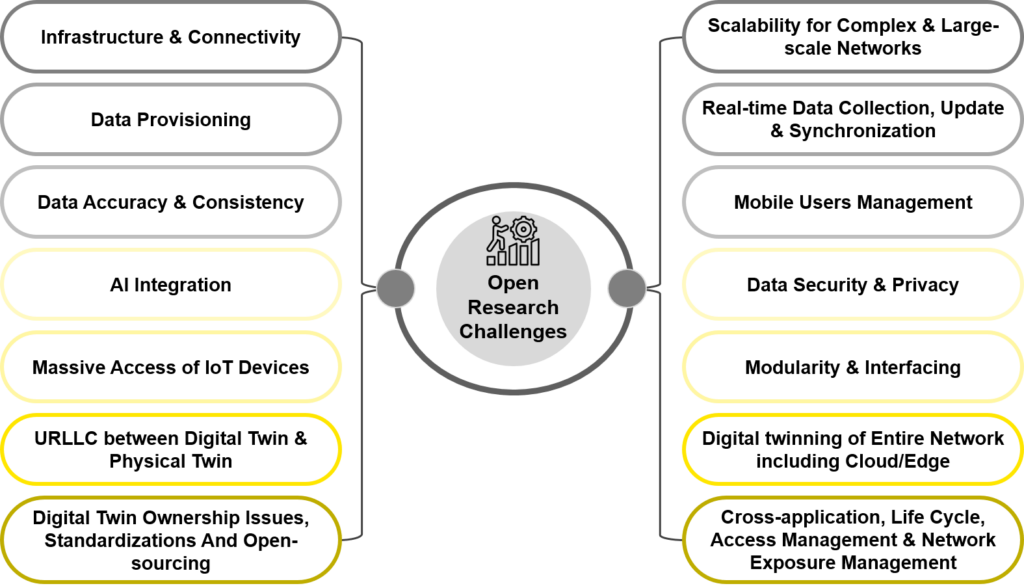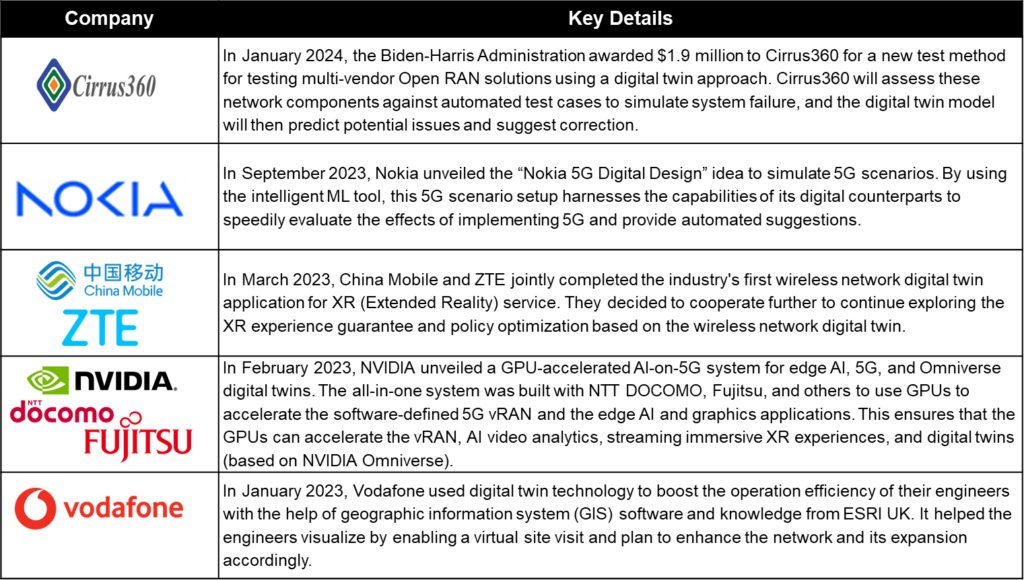As the complexity and scale of the 5G network expand to change industries, efficient, secure management and optimization become increasingly important. Along with this, the need to modify or update the network infrastructure and deploy and optimize advanced networking standards such as network slicing, software-defined networks, and network function virtualization presents new complexities and challenges. To address these challenges and enhance the capabilities of current and next-generation networks, digital twin (DT) has gained importance as a promising technology.
The following article will present information on the digital twin framework, its utilization for NGNs, the varied types of digital twin use cases for implementing it in the next-generation networks, the innovation synopsis, and the market presence.
What is the Digital Twin Framework and its Implementation in Next-Generation Networks?
The next-generation networks (NGN) include advanced 5G, 5G non-terrestrial networks (NTN), 6G, innovative optical and wireless networks (IOWN), and other new networks. These are designed to be more capable and efficient than traditional mobile networks, offering improved performance, reliability, scalability, flexibility, agility, and security.
The digital twin framework is a network management model that enables NGNs interactive virtual-real mapping and control. It aims to perform continuous monitoring, assessment, and evaluation of performance to predict the network changes’ impacts, optimize network management, and make appropriate decisions to ensure that the NGNs behave accurately.
Within the NGN digital twin, the digital model operates alongside the physical network to perform operational predictions and implement optimized decisions into the real network and its associated services. Further, based on the network users behavior, the NGN digital twin provides benefits such as security, network maintenance, QoS control, self-configuration for planning network, and others.
The figure below shows the digital twin framework in a three-tier architecture wherein a closed loop is formed with the physical entities and their counterparts.

Figure 1: A reference architecture proposed by the ITU for a digital twin network with interfaces between different layers designed to form a closed loop between the physical layer and application layer
The three-tier digital twin framework comprises a physical layer, a digital twin network layer, and an application layer. The key architectural blocks are as follows:
Tier 1: Physical Layer:
The physical network layer refers to the real-world next-generation network that consists of physical network elements such as a core network, access network, network design & planning, and their operating environment. Depending on the need, the physical layer may span from a single domain to multiple domains. It targets different physical parts of NGNs, such as a radio cell, a radio access network, a transport network, and a core network or the entire end-to-end NGNs. It exchanges data and controls messages with the digital twin layer.
Tier 2: Digital Twin Network Layer:
This layer provides an interactive platform based on real-time information and configuration (of the physical network). It comprises three domains: data repository domain, data services model domain, and digital twin entity management domain.
- Data Repository domain: This domain comprises the data repository and collects real-time data from the physical network layer to build accurate and up-to-date models in the twin. It stores the data in heterogeneous databases. Its functions involve data collection, storage, service, and management to provide data upon request for creating models and managing the data during its lifetime.
- Data Services Model Domain: This service-mapping model domain represents the real-world entities in the physical network based on the collected data. It leverages the services to improve the digital twin’s agility and programmability. There are two types of models in it.
- Basic Models: These models replicate the real-time characteristics and state of the physical network related to its topology, elements, and network slices. The models help verify and emulate control changes and implement optimized solutions safely and cost-effectively before the new configuration is sent to the physical network.
- Functional Models: These refer to analytical models that are leveraged to perform traffic analysis, prediction, network emulation, fault diagnosis, etc., extract insights from the digital twin for specific use cases, and help optimize network configurations to gain better performance.
- Digital Twin Entity Management Domain: This domain is responsible for the life-cycle management function of the NGN’s twin layer. It enforces the digital twin layer with three key controllers: security management (e.g., authentication, authorization, encryption, and integrity protection), model management (e.g., model creation, configuration, update, and monitoring), and topology management.
Tier 3: Application Layer:
The NGN application layer encompasses various network application functions that exploit the NGN’s twin layer. It intends to use the twin layer or make requests, emulating the required services and, if needed, sending control messages to the physical network layer. These functions include network virtualization, real-time monitoring, anomaly detection, network parameters tuning, algorithmic solution testing, network management, and others.
The framework may include a double-closed loop formed collectively by the layers. The first inner loop involves emulating the physical network elements and optimizing their virtual counterparts based on the data services models. Additionally, the second outer loop includes controlling and optimizing physical network elements via feedback from network applications or based on the three-layer architecture.
How is Digital Twin utilized in Next Generation Networks (NGNs)?
Next-generation networks benefit significantly from digital twin technology across various domains. This section highlights the potential use cases of the digital twin across multiple domains of NGNs.

Figure 2: Use Cases of digital twin for Next-Generation Networks
Digital Twin for Network Design & Planning
The digital twin technology enables network planning entities to improve their network designs and plans by helping them overcome the challenges related to scalability and network configuration. In addition to this, with digital twin technology, network designers can generate a virtual network model and perform simulations to analyze the real-time behavior of network subsystems like network-bearing structures, antennas, baseband units, etc. The designers spot potential issues and address them before they impact the site operation or performance while delivering a good quality of service at reduced capex.
Digital Twin for Access Networks
The digital twin for the access networks or radio access networks (RAN) is utilized to visualize the traffic demand in cell areas to predict the user density and data demands to minimize the wastage of resources and energy. Various parameters are considered while building the digital twin for RAN, such as backhaul link quality, network nodes, multi-path fading, co-channel interference, and others. Also, the DT makes predictions related to real-time operations and service requirements at different access nodes. Thus, testing RAN moderation and traffic steering becomes a practical solution in the real environment.
Digital Twin for Core Networks
The digital twin of the core network can provide several benefits by efficiently monitoring the network. It can generate precise end-to-end (E2E) parameter metrics for carrying out dynamic and independent network orchestration, satisfying the QoS requirements. Moreover, the digital twin creates a digital replica of the core network and tests several what-if scenarios related to network slicing, resource allocation, policy control, session management, and others without impacting the physical network.
Innovation Synopsis
The innovation synopsis section comprises the IP and research activities in the NGN digital twin. The figure below symbolizes the patent filing for the last ten years. Patent filing in this domain started in 2018, and the highest number of patents were filed in 2022. We expect the patent filings to follow a similar trend, and the number of patents filed will increase gradually in the upcoming years.

Figure 3: Digital twin for Next Generation Network Patent Filing
Note: The number of patent filings in 2023 is low because the patent publication takes 18 months for the prosecution process, wherein the filed patents are not available in the public domain.
From the above discussion, it is clear that the digital twin technology is essential for deploying NGN services. However, the research field for this technology is still in its early stage, as the instantiation, maintenance, and lifecycle management of digital twin real networks raises multiple open challenges that must be addressed. The figure below describes the open research challenges and the future direction for deploying the digital twin in the NGNs.

Figure 4: Open research challenges and future direction for using digital twins in the Next Generation Networks
Market Synopsis
For developing Next-Generation Networks, the need to efficiently optimize network configuration, real-time monitoring, network management, and precisely guarantee QoS for different services has become a great industry interest. The following table includes the market activities of the key players in the digital twin for the NGN domain.
- Cirrus360 received USD 1.9 million from the Biden-Harris Administration in January 2024
- Nokia unveiled 5G Digital Design in September 2023
- ZTE and China Mobile jointly accomplished the first wireless network digital twin application for XR in March 2023
- NVIDIA, with Fujitsu, NTT DOCOMO, and others, unveiled a GPU-accelerated AI-on-5G system for edge AI, 5G, and Omniverse digital twins in February 2023
- Vodafone used digital twin technology to boost operation efficiency in January 2023

Table 1: Key Market Activities of the Players in the Digital Twin for the NGN
Conclusion
Digital twin for the NGNs takes a transformative leap forward in making better decisions, enhancing productivity & operational efficiency, and reducing cost by enabling precise and thorough network perspective. Also, it opens ways for innovative, resilient, and customer-centric services. The cutting-edge digital twin technology has thus changed how NGN should be planned, maintained, and responded to the dynamic market requirements by shaping the NGN into a robust and future-ready infrastructure. However, many open-research challenges must be focused on, such as security, privacy, AI integration, complexity and scalability of entire networks. Thus, the future direction for these challenges is the solutions where the new techniques evaluate and explain predictions and decisions performed by digital twins by allowing their deployment in real environments.